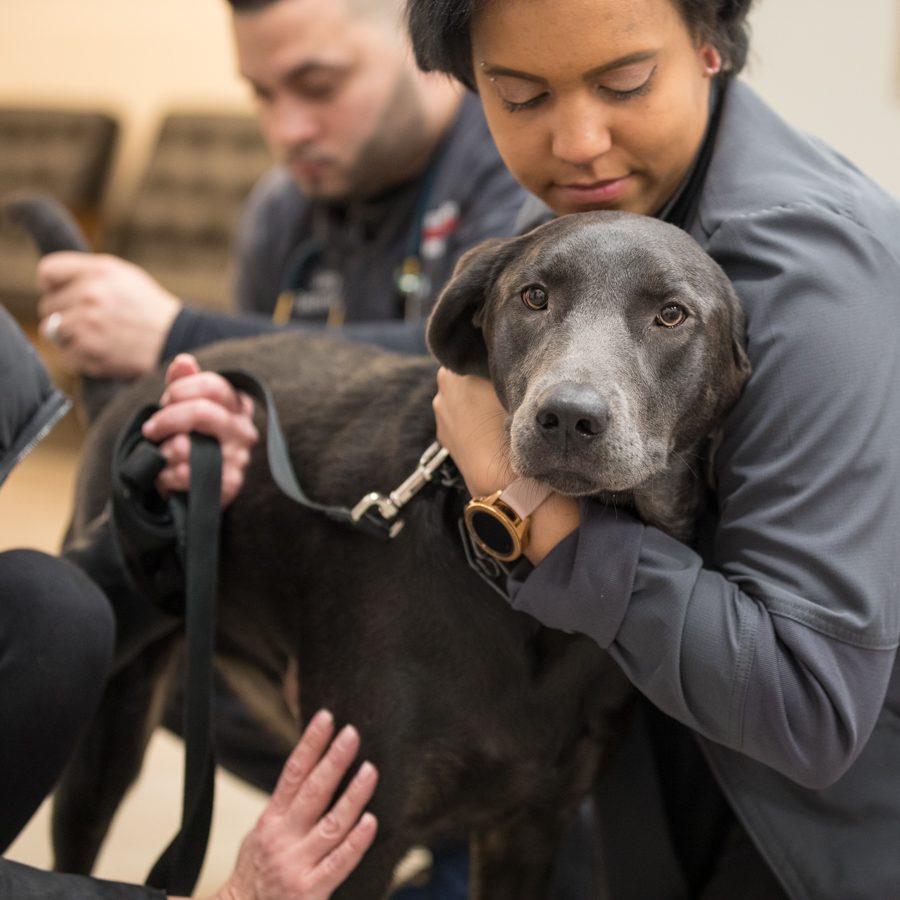
How to Know if Your Dog is in Pain
Dr. Cassie Knapp
Call & Speak with a doctor Open 24/7, Even Holidays!
Walk in today for:
Emergencies
Point-of-Care Ultrasound
Urgent Care
X-Rays
Diagnostics + Testing
End-of-Life Care
Surgery
Treatment + Hospitalization
Are you a dog owner? Do you know how to recognize signs of pain in your dog? How can you tell whether or not your dog is experiencing pain?
If you’ve ever found yourself wondering how to tell when your dog is hurting, you’re not alone. In the article below, you’ll find a quick list of common signs you can look for that may indicate pain in your dog. You can use this information to understand your pet’s needs better, and to recognize when you may need to take her to an emergency vet as well. Read on to find out more.
Signs of Pain
Listed below are signs that can indicate pain in your dog:
Whining and Vocalizing
Some dogs are very quiet when they’re hurting. Others, however, are much more vocal about it. The worse the pain, the louder the dog tends to be; if your dog is severely injured, she may be unable to stop herself from vocalizing as a result of the pain she is experiencing.
If your dog is whining or making other noises and you aren’t sure why, look her over closely. She may just be nervous about something, or she could be upset about something she can see out the window. However, the chance of pain is relatively high when you notice this type of odd behavior in your pet, too.
Pacing and Restlessness
Pacing is commonly seen in dogs with stomach pain and nausea, but it can be seen in other types of pain as well. Restlessness goes along with pacing and is very similar in terms of its appearance and underlying causes too. Both pacing and restlessness can indicate that your dog is unable to lay down and get comfortable enough because of her pain.
It is possible that dogs can also be restless or exhibit pacing behavior from anxiety. If you know your dog is very anxious, this behavior alone may not help you determine when she is in pain.
Hiding and Guarding
Hiding behavior is possibly the most common sign of pain in dogs. Most dogs prefer to hide their pain, and they may go so far as to hide under the bed, in a closet, or in some other location where they cannot be easily bothered by their human family members.
Dogs may also guard themselves more frequently when they are in pain. If you try to pet your dog and she snarls, growls, or becomes afraid, this can be a sign that she is guarding herself as a result of some type of pain.
Aggression and Defense
Dogs who are not normally aggressive but suddenly become aggressive without an obvious reason may be in pain. This sign can also let you know that a dog is sick or is suffering in some other way, too.
Additionally, if your dog becomes defensive very easily when she did not normally do this before, she could be in pain. Both aggression and defensive behavior look very similar to each other, and they can both be a good way to tell when an otherwise calm and docile dog is dealing with an underlying health problem. Take your pet to the vet if her behavior suddenly changes like this.
Clinging and Separation Anxiety
Sometimes, dogs who are in a lot of pain may become clingy instead of standoffish. This response is not as common as some others on this list, but if your dog’s behavior suddenly changes—even if she becomes clingy toward you—then this may let you know she is in pain.
Separation anxiety without other causes can also indicate pain, and it may be a side effect of clingy behavior from pain as well. Typically, it is important to pay attention to your dog’s behavior and recognize when something changes suddenly.
Loss of Appetite and Loss of Energy
Another common sign of pain in dogs is a loss of appetite. Loss of energy typically goes along with this sign as well.
Keep in mind, however, that a loss of appetite and a loss of energy are both associated with almost any canine illness or condition. They may not necessarily indicate pain, but they can tell you that something is going wrong and needs to be assessed by a vet as soon as possible, too.
Contact VEG if Your Dog is in Pain
Based on this information, it’s easy to see just how complicated canine pain can become. Many dogs are great at hiding their pain, because they don’t want to worry or scare their human family members. If your dog typically hides her pain, it is important to learn how to recognize the less common signs of pain in pets too.
If you know or suspect your dog is in pain, take her to the vet or emergency vet, depending on the level of pain and the underlying cause in question. Your vet can help you find the right treatment or management solution depending on the source of your pet’s pain.
Contact VEG by calling one of our locations. We have locations all over the country, which are all open 24/7, including holidays. When you call VEG, you’ll talk with an emergency veterinarian who will help guide you in the best direction and offer advice on what to do next for your pet.

